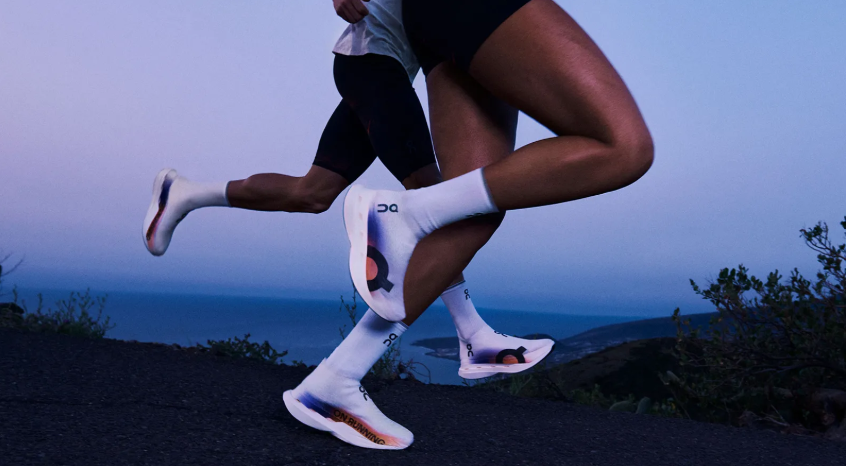
Introduction
Running shoes are more than just gear—they’re a runner’s best friend, especially for amateur runners just starting their journey. They cushion every step, protect against injuries, and, with the right choice, can even enhance performance. For runners of all levels, the right shoe can mean the difference between loving the sport or struggling through every mile. Whether you’re tackling your first 5K or dreaming of marathons, understanding the importance of running shoes is key to enjoying the journey and staying injury-free.
In this blog, we’ll explore why shoes matter, the science behind the latest innovations, and what’s on the horizon for 2025. Get ready to dive into the world of super shoes, carbon plates, and the never-ending race for the ultimate footwear.
Why Are Shoes So Important for Amateur Runners?
For beginners, running is a high-impact sport. Proper running shoes can:
- Provide Support: Amateur runners often lack refined technique, leading to a higher risk of overuse injuries like shin splints or plantar fasciitis. Shoes with good arch support and cushioning mitigate these risks by stabilizing the foot and absorbing shock during repetitive motions.
- Boost Confidence: Wearing shoes specifically designed for running (and not cross-training or walking) can give beginners the confidence to commit to their training. Feeling prepared and equipped makes it easier to hit the road or trail without hesitation.
- Reduce Fatigue: The right pair can ease joint stress, keeping legs fresher for longer runs and reducing post-run soreness. Lightweight designs with effective cushioning ensure energy is preserved during each stride.
- Prevent Injuries: Properly fitted shoes address individual biomechanical needs, whether it’s correcting overpronation or providing extra cushioning for high arches. This proactive approach to footwear can dramatically reduce the likelihood of common running injuries.
In short, investing in a quality pair of running shoes is essential for anyone starting their running journey. It’s not just about comfort—it’s about creating a foundation for sustainable progress and enjoyment in the sport.
The Evidence on Super Shoes and Carbon Plate Technology
Super shoes, with their carbon plates and ultra-responsive foam, have taken the running world by storm. But what does the science say about these high-tech shoes? And more importantly, can amateur runners benefit from them?
What the Research Shows:
- Enhanced Energy Return: Studies have shown that shoes with carbon plates, like the Nike Vaporfly or Adidas Adizero Pro, improve running economy by up to 4%. This means less energy is required to run at the same speed. For both elites and amateurs, this translates to less fatigue and potentially faster times.
- Injury Reduction: Some research suggests that the added cushioning and structured design of super shoes may reduce impact forces, potentially lowering the risk of overuse injuries. The advanced foam materials absorb shock more effectively, which could be beneficial for runners who train on hard surfaces.
- Performance Boost: While elite runners have seen significant performance gains, the benefits are not exclusive to professionals. Amateur runners can also experience faster times, improved endurance, and reduced fatigue—though the gains may vary based on fitness level and biomechanics.
Are They for Everyone?
Yes and no. Here’s why:
- Yes, amateurs can use them: Super shoes are not just for breaking world records. Many recreational runners use them for races and speed workouts to feel faster and more efficient. The psychological boost alone can be worth the investment for some runners.
- No, they’re not ideal for everyday training: The high price tag and specific design of these shoes make them better suited for race days or key workouts rather than daily mileage. Frequent use can also wear down the specialized foam more quickly, reducing their lifespan.
Additionally, while super shoes can enhance performance, runners without a solid aerobic base or proper technique might not fully capitalize on their benefits. For these individuals, focusing on consistent training and strengthening biomechanics should take priority.
Why Are Brands Racing to Release New Shoes?
The running shoe industry is in a frenzy, with brands unveiling new models at breakneck speed. What’s driving this? Is it just innovation, or is it a full-blown arms race?
The “Shoe Wars” Phenomenon:
- Competitive Edge: Each brand is vying to create the next “fastest shoe,” spurred on by Nike’s dominance in the super shoe market. Athletes achieving personal bests or podium finishes in a specific brand’s shoe leads to massive marketing opportunities. For example, the rise of carbon plate technology has made shoe innovation a hallmark of athletic success.
- Consumer Demand: Runners, from elites to amateurs, are eager to try the latest and greatest innovations. The idea that “a shoe can make you faster” drives sales and generates buzz on social media and within running communities.
- Technological Advancements: Breakthroughs in foam, plate designs, biomechanics, and materials are fueling rapid development. With each iteration, brands seek to fine-tune their designs to cater to more specific runner needs—from ultramarathons to short-distance sprints.
In short, brands are in a constant battle to outdo each other—and runners are reaping the benefits. This race to innovate has led to a golden era of footwear options, but it also raises questions about affordability and sustainability in the long term.
What’s Coming in 2025?
2025 promises an exciting lineup of new running shoes. Here are some highlights:
- Saucony Endorphin Elite 2
- Enhanced energy return with a seamless upper and 3D-molded heel.
- Release: Early 2025.
- Altra Lone Peak 9
- Improved durability and comfort for trail runners, with a wider toe box and enhanced traction for technical trails.
- Release: January 2025.
- Nike Vomero 18
- Highest stack height yet (46mm) for ultra-cushioned long runs. Perfect for recovery runs and endurance athletes.
- Release: February 2025.
- Hoka Cielo X 1 2.0
- Lighter weight for a more responsive ride. Built with a focus on speed and comfort for track athletes.
- Release: Details TBD.
- Brooks Hyperion Elite 5
- Updated cushioning with a carbon plate for speed. Ideal for competitive runners chasing personal bests.
- Release: 2025.
- Puma Deviate Nitro Elite Trail
- Nitro Elite foam adapted for trail running, offering lightweight cushioning and grip for off-road adventures.
- Release: 2025.
- On Cloudboom Strike LightSpray
- Laceless, robotic spray-on upper for a seamless fit.
- Release: Broad availability in 2025.
New Technologies to Watch
Innovation doesn’t stop with new models. Here’s what’s set to shake up the running shoe market in 2025:
- Spray-On Uppers: As seen in On’s Cloudboom Strike LightSpray, robotic spraying could revolutionize shoe fit and weight. This technology aims to eliminate seams and provide a custom fit for every runner.
- Biodegradable Materials: Sustainability is becoming a key focus, with more brands using eco-friendly materials to reduce their environmental footprint. Expect to see more shoes that balance performance with planet-friendly initiatives.
- Advanced Biomechanics: Shoes designed to work with individual gait patterns, offering personalized support and efficiency. Machine learning and wearable sensors may play a role in crafting shoes that dynamically adapt to the runner’s stride.
- Enhanced Sensors: Integrating smart technology to track running metrics like cadence, foot strike, and ground contact time directly from the shoe. This data could offer insights for training optimization and injury prevention.
The future of running shoes isn’t just faster—it’s smarter, more personalized, and greener.
Conclusion: Do Shoes Really Make You a Better Runner?
The evidence is clear: shoes can help, but they’re not magic. Here’s the bottom line:
- Shoes Can Boost Performance: Super shoes with carbon plates and responsive foams improve running economy, but the gains are most pronounced when combined with proper training. The shoes amplify what the runner has already built through dedication and effort.
- Characteristics for Maximum Benefit: To truly take advantage of advanced shoes, runners should:
- Develop strong biomechanics and efficient form.
- Build a solid aerobic base through consistent training.
- Reserve high-tech shoes for races or key workouts to preserve their longevity.
Running shoes are evolving faster than ever, offering incredible benefits for runners of all levels. But remember, no shoe can replace the value of consistent training, proper recovery, and a passion for the sport. Invest in the right pair, but don’t forget to put in the miles—because at the end of the day, it’s your legs and heart that get you across the finish line.
Happy running! 🏃♂️🏃♀️
References:
General Research and Evidence:
- Nike Vaporfly and Super Shoe Studies – https://www.runnersworld.com
- Running Economy with Carbon Plates – https://www.sciencedirect.com
- Benefits of Cushioning for Injury Prevention – https://www.ncbi.nlm.nih.gov
Running Shoe Innovation and Market Trends:
- Carbon Plate Technology and Super Shoes – https://www.runnersworld.com/gear/a20862093/what-are-carbon-fiber-plate-shoes/
- The Evolution of Running Shoe Technology – https://www.roadtrailrun.com
- Sustainability Trends in Running Shoes – https://www.greenrunners.org
Specific 2025 Running Shoes:
- Saucony Endorphin Elite 2 – https://www.saucony.com/endorphin-elite-2
- Altra Lone Peak 9 – https://www.altrarunning.com/lone-peak-9
- Nike Vomero 18 – https://www.nike.com/vomero-18
- Hoka Cielo X 1 2.0 – https://www.hoka.com/cielo-x1-2025
- Brooks Hyperion Elite 5 – https://www.brooksrunning.com/hyperion-elite-5
- Puma Deviate Nitro Elite Trail – https://www.puma.com/deviate-nitro-elite-trail
- On Cloudboom Strike LightSpray – https://www.on-running.com/cloudboom-strike
New Technologies to Watch:
- Robotic Spray-On Shoe Technology – https://www.voguebusiness.com
- Advanced Biomechanics in Running Shoes – https://www.runnerslab.com
- Integration of Smart Sensors in Footwear – https://www.wearabletechinsights.com
- Biodegradable Materials in Running Shoes – https://www.sustainablefootwear.com
Let me know if you’d like me to refine this further or provide additional references! 😊



